Iris, meaning ‘rainbow’ in Greek, is an elegant flower. It is named after the Greek goddess who is considered the messenger of LOVE.
Many monarchs throughout history have used so-called ‘fleur de lis’ as a symbol of their royal houses.
You can also see this flower on coats of arms and flags of many noble families and some countries.
Among 300 species of this flower, you can find those thriving in deserts, swamps, as well as in cold or temperate climates. I adore all varieties of this flower, no matter what color their flowers are.
Pick out among white, yellow, orange, pink, blue, red, purple, brown, multiple, and black blooms available and enjoy.
Groups of Irises
Iris symbolizes eloquence, but each color has its own meaning. For example, the white variety is a symbol of purity. Purple one symbolizes wisdom. Also, blue one represents faith and hope, and yellow variety is a symbol of passion.
There are two primary groups of this plant, with countless varieties, species, and hybrids.
Groups of Iris |
|
|
Bearded Iris types |
Beardless Iris types |
| Border Bearded Iris |
Louisiana Iris |
|
Tall Bearded Iris |
Japanese Iris |
| Intermediate Bearded Iris |
Siberian Iris |
|
Miniature Tall Bearded Iris |
Dutch Iris |
| Dwarf Bearded Iris |
Blue Flag Iris |
|
Miniature Dwarf Bearded Iris |
Yellow Flag Iris |
Rhizomatous Iris

This type flourishes in summer. They have recognizable thickened stems, which grow horizontally. Their growth can be fully or partially underground. You will like their overlapped, sword-like leaves growing from rhizomes. There are three categories of this type of Iris:
Bearded – These Irises are definitely the most familiar and widely grown in the world. You can quickly recognize them thanks to their prominent ‘beard.’
This type of Iris has four parts, including the beard, standards (inner upright petals), stigma flaps, and three falls (outer hanging petals). They are made of colored or white hairs in the center of every fall.
Beardless – This type of Iris has standards, stigma flaps, and falls, as well as crests in some cases. The most popular varieties are:
-
- Louisiana variety is an excellent choice if the soil in your garden is moist
- Siberian variety is highly adaptable. You should choose it if you have no much time for maintenance of your plants
- Pacific Coast variety is a perfect match for regions with dry summers and rainy winters
- Japanese variety is a plant of choice for wet conditions
Crested – Pick out this flower if you live in the hot region, and can provide full sun and moist, humus-rich ground for your lovely flower. It has standards, stigma flaps, falls, and crests on the falls of each flower.
Blooms can be white, blue, or violet, surrounded by leaves arranged on 2 to 80 inches (5 cm – 2 m) tall bamboo-like stems.
Bulbous Iris
This gorgeous type flourishes in late spring. It shed the foliage after the blooming season and goes dormant throughout summer. Its most popular varieties are:
- Dutch hybrid flourishes earlier in the season and represents favorable part of spring bouquets.
- Dwarf (reticulated) variety is an excellent choice if you want to grow your flowers in groups. Don’t forget to divide it once in two to three years.
The Most Popular Varieties of Iris
Iris is a flower which comes in many forms, sizes, shapes, and colors. The offer on the market is excellent, and you just need to choose the option you like best. I will list you here my favorite varieties. Let’s enjoy them together!
The most popular varieties of Iris |
|||
|
Variety |
Flowers | Height | Blooming season |
| Queen’s Circle | White flowers with lavender fringes | 32 inches (0.81 m) |
Late midseason |
|
Jesse’s Song |
White and violet flowers | 35 inches (0.89 m) | Early midseason |
| Thornbird | Yellow flowers | 37 inches (0.94 m) |
Late midseason |
|
Dusky Challenger |
Dark purple flowers | 39 inches (0.99 m) | Late midseason |
| That’s All Folks | Yellow-gold flowers | 40 inches (1.1 m) |
Midseason |
How to Plant Iris Flower in Your Garden
Propagation by rhizomes
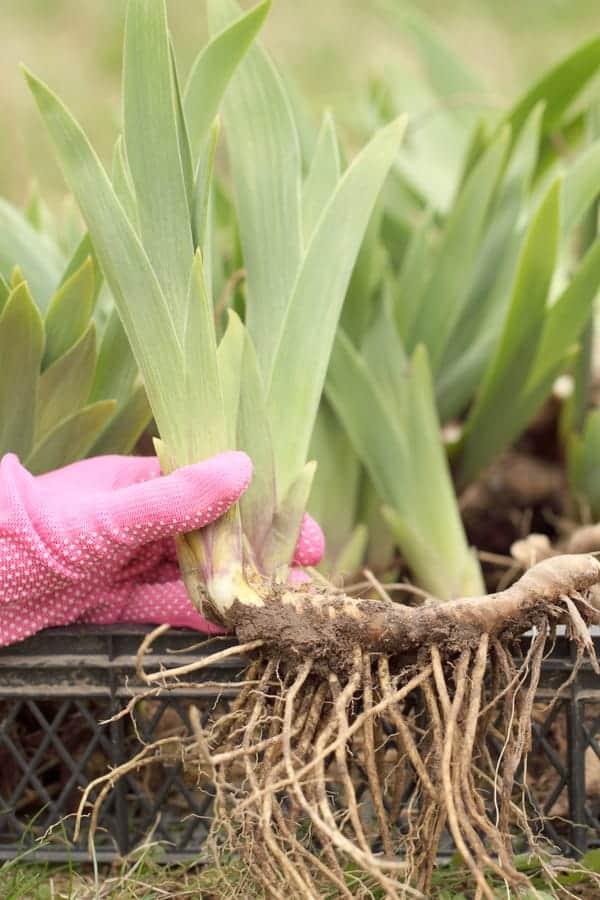
The best time to plant your Iris is early fall, from September to October when the temperatures are still 40 to 50 F (4.5 – 10 C) during the night. That way, your plant will have enough time for establishing roots before the end of the season.
You may consider planting them in a raised bed with excellent drainage. However, you can also grow this flower in the garden if the place is suitable.
The crucial thing is preparing the spot at least 10 – 15 days before planting. Start with loosening the ground with a garden fork at least 10 to 12 inches (25.5 – 30.5 cm) deep. It will help in establishing necessary drainage.
It is recommended to mix a 2 to 4 inches (5 – 10 cm) thick layer of organic compost with the soil as well.
Use a digging shovel and dig a shallow, 4 inches (10 cm) deep hole, at least 10 inches (25.5 cm) in diameter. Make a small earthy ridge in the middle and place rhizomes there, with roots spreading down all sides.
Add the soil, but leave parts of rhizome uncovered. If your Iris doesn’t bloom, the probable reason is too deep planting.
The best choice is planting rhizomes in groups of three. Depending on their size, keep them 12 to 24 inches (30.5 – 61 cm) apart. On average, it is six bulbs per 1 sq ft (0.09 m2).
Propagation by dividing
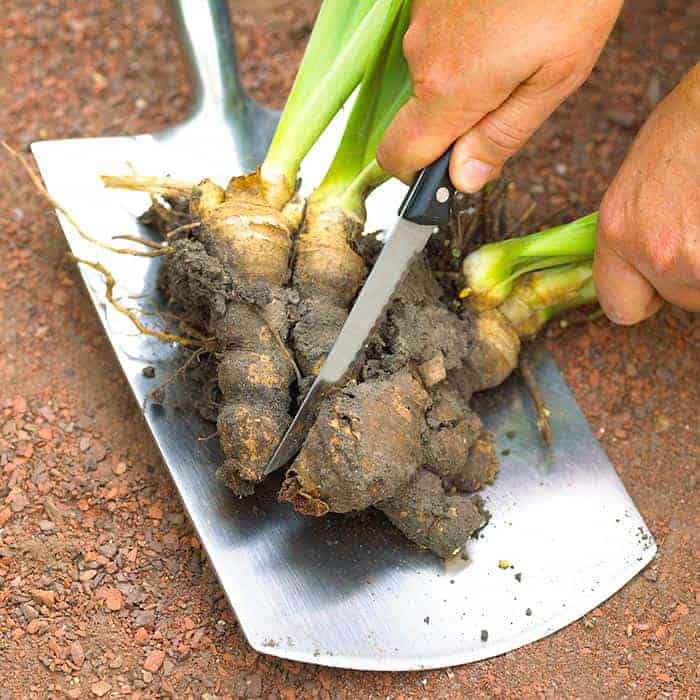
You should divide rhizomatous Iris at least once in every three to five years. Do it in midsummer, right after the blooming time passes. Left undivided, rhizomes bury itself more in-depth in the ground over time. As a result, your Iris will reduce blooming.
When you notice a decrease in the number of flowering, it is the time for dividing rhizomes. Make it easy for yourself and don’t cut leaves after the flowers wilt. That way, you will know where the rhizomes are without digging around.
When the moment comes, dig up your rhizomes carefully and divide them. It is not a hard job, and you can pull them apart with your own hands. If some rhizomes are too tight, you may cut them with a garden knife.
Use just healthy, 0.75 to 1 inch (1.9 – 2.5 cm) long rhizomes with well-structured roots. Throw away all unhealthy, infected, rotting, soft, hollow, and old ones.
Trim the foliage to 4 to 6 inches (10 – 15 cm) height to let the plant develop new roots more quickly. Then re-plant rhizomes in the middle of the previously made earthy ridge, with roots spreading down all sides. In the end, water new plants abundantly.
How to Care Iris in Your Garden
Soil
It requires the fertile, slightly acidic, sandy, or even gravelly ground to thrive. If the soil in your garden is too heavy or poorly drained, you should make it lighten by adding compost or gypsum.
The other solution is to plant your flower in raised beds. Keep in mind that Japanese iris prefers growing on the lime-free soil.
Light
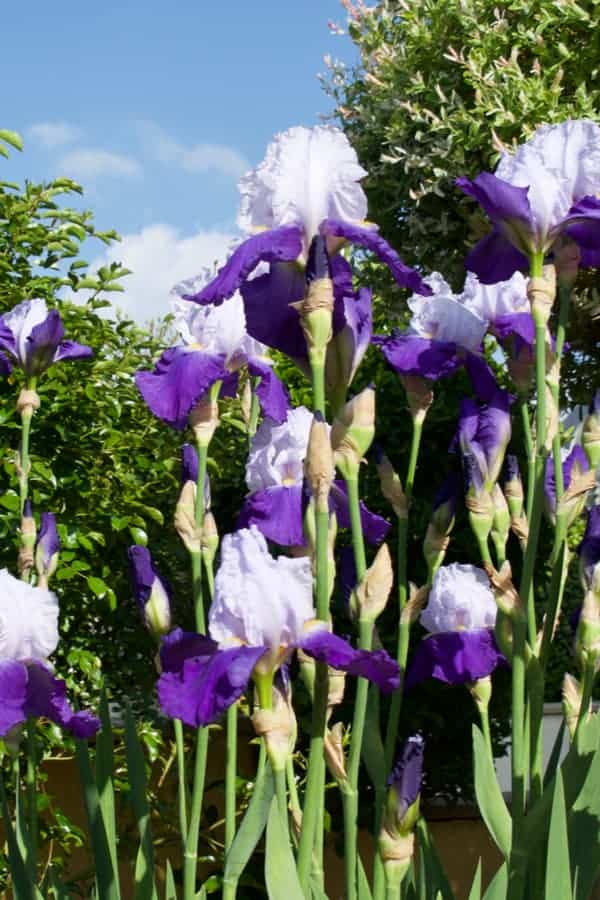
Iris will grow healthy and vigorous only if you plant it at the place with full sun. Left in full shade, your plant won’t bloom abundantly and may suffer from fungal diseases as well.
Temperatures
Iris doesn’t mind being exposed to the extreme temperatures, as long as the soil is well-drained. If the ground stays soggy because it can’t drain away snowmelt or excess rain, you will have an issue with root rot.
Watering
Although Iris needs the moisture soil for healthy growth, you need to provide excellent drainage for it to prevent root rot. Water your plant when the top 2 inches (5 cm) of the ground becomes dry.
While watering, you should do it deeply, especially during hot summer days or long periods of drought.
Anyway, it is always better if you leave it dry than waterlogged. Pay attention that Japanese, Louisiana, and Siberian Irises need more water than other varieties.
Fertilizing
Apply a thin layer of compost, bone meal, or an all-purpose, low-nitrogen 6-10-10 fertilizer around the base of your plant. Do it in spring before your flower begins blooming.
It is essential to avoid adding an excessive amount of nitrogen because it encourages the growth of the foliage instead of flowers.
Mulching
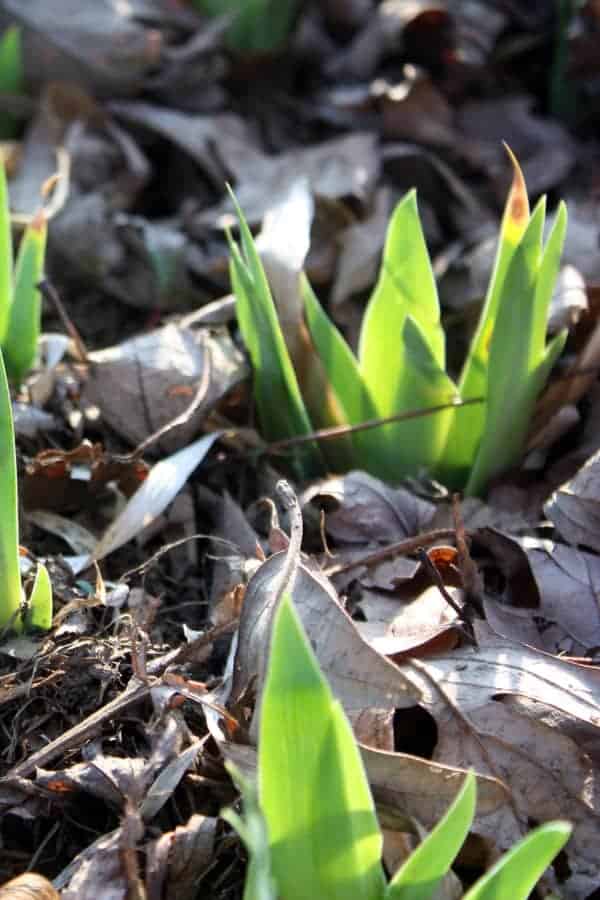
Be sure to apply a layer of mulch once the ground has frozen in winter. That will prevent roots from growing out of the ground while the soil freezes and thaws alternately.
Since you need to leave the planted rhizomes exposed, you should add mulch away of the stem and leaves to avoid rotting.
Supporting
Usually, Iris doesn’t require any support. The only exceptions are taller varieties, which may fall over without proper help.
Pruning and deadheading
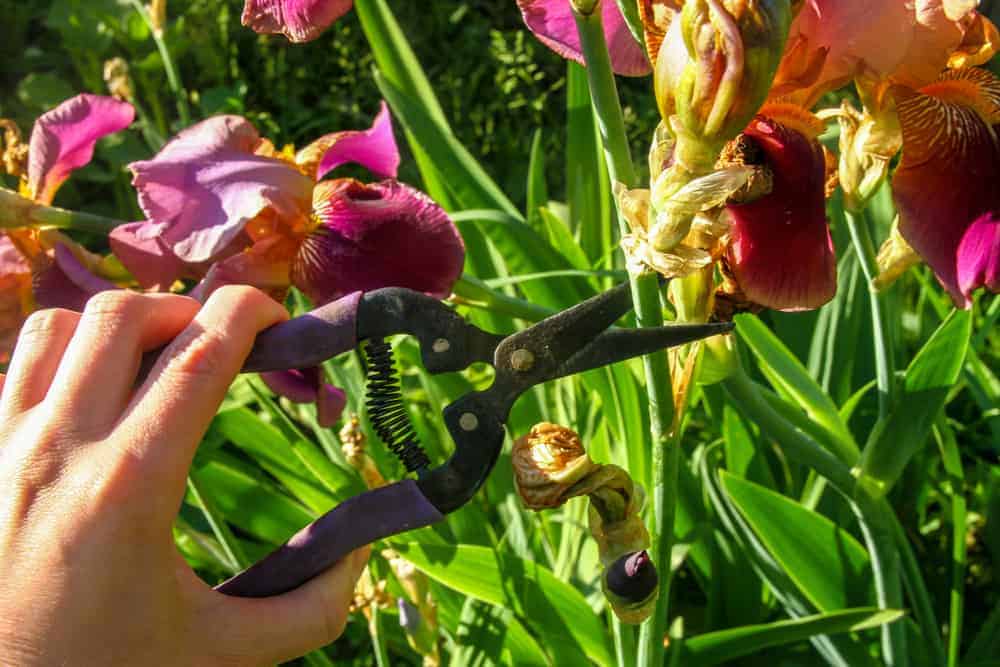
Iris requires consistent deadheading. You need to remove all spent flowers if you want your plant to flourish again. For example, Bearded Iris will bloom several times in a row on buds placed along the stems.
Once flowering is finished, you should prune flower stems at the base, but don’t cut leaves. They are necessary for photosynthesis, and you can’t expect your plant properly grows the following year without enough foliage.
The only thing you should do is to remove leaves after a hard frost. Plus, it is always better to cut yellowed and spotted foliage when needed. When autumn comes, you can prune all the foliage to an approximate height of 4 to 5 inches (10 – 13 cm).
Dividing
The division is an integral part of the care of this flower. You need to divide them at least once in two to five years. The best moment for this action is late summer.
Take care to leave one or two leaf fans on each division. Always throw away older rhizomes with a few white feeding roots.
Iris Flower Pests and Diseases
Rust
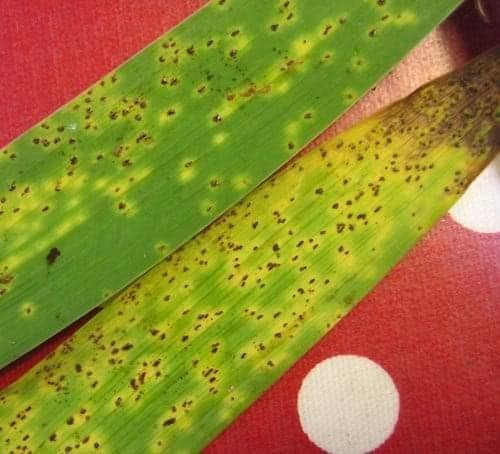
After the period of blooming, you may see brown spots on the foliage. Use a quality fungicidal spray to keep the disease under control.
Collect and burn wilted leaves to prevent additional spreading of this infection.
Scorch
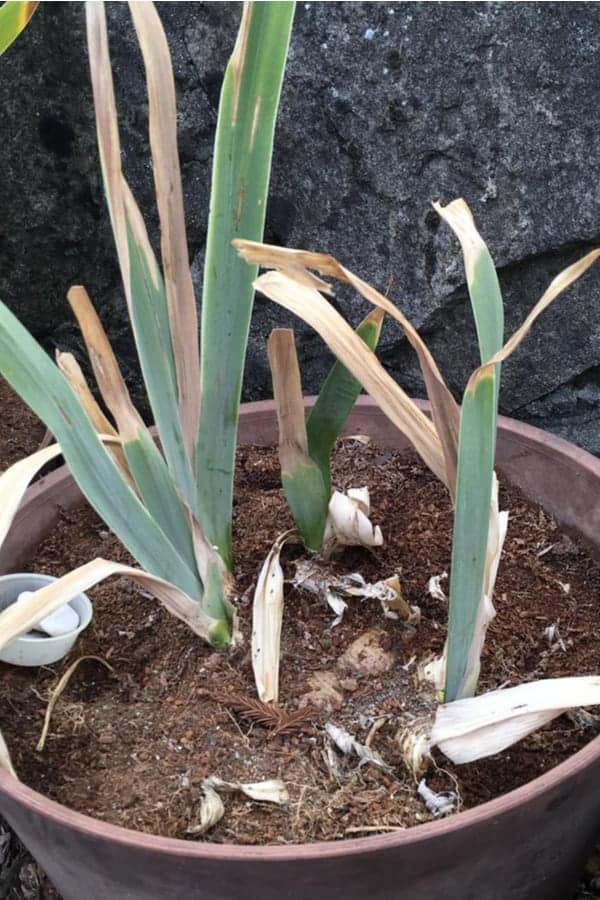
Affected leaves will start dying back from its tip. They become orange first and turn brown over time.
The weird thing is that you can find only one infected plant while others stay healthy and vigorous.
There is no cure against this problem except burning brown foliage to prevent spreading the infection.
Rot
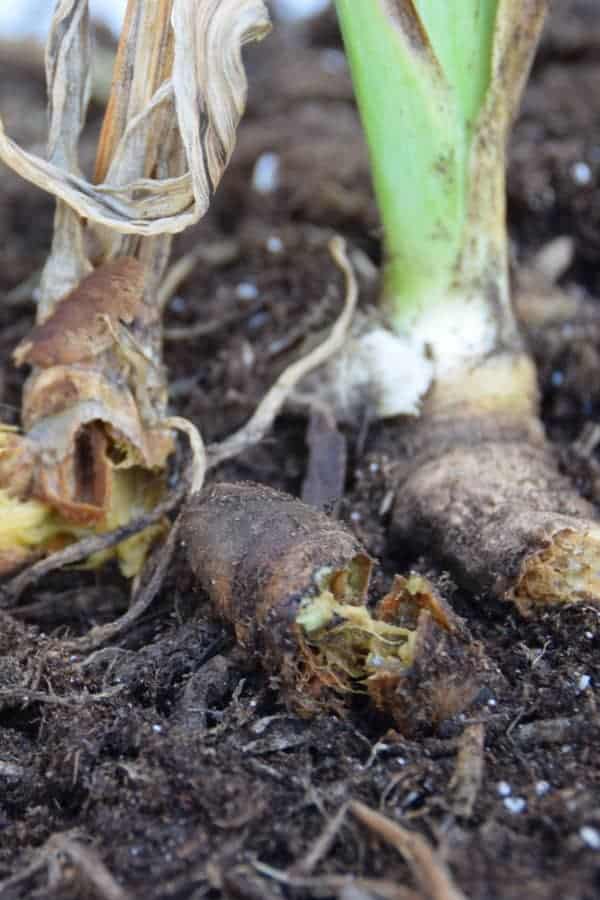
Once attacked, rhizomes will become yellow, stinky, and soft.
Burn all the bad parts of the plant and remove the soil where your Iris was placed to prevent additional spreading of the infection.
Aphids
These insects suck sap from the foliage and spread various diseases between companion plants.
You can’t prevent aphids from coming in your garden, but you definitely can attract beneficial insects, which eat these bugs.
Once you discover them, you should spray your Iris with a soap solution to get rid of pests.
Iris Borer
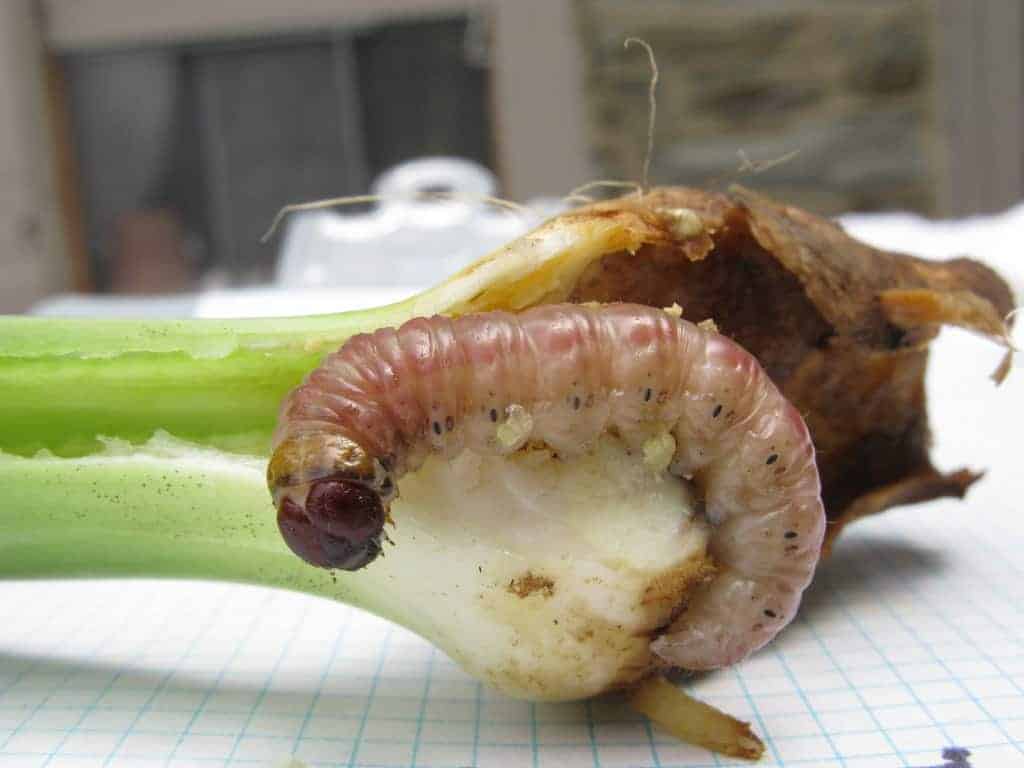
These pests lay eggs on old leaves in autumn. After hatching in early spring, they feed on the new foliage and leave a slimy trail all over the plant.
Since Iris borer can cause havoc on your flowers, you should work on prevention. The best way is to keep the yard clean.
Once they appear, try to squash them between fingers or spray the plant with a soap solution.
Slugs and snails
They feed on newly planted seedlings and flowers. Prevent them from coming by using beer traps, or handpick them when come.
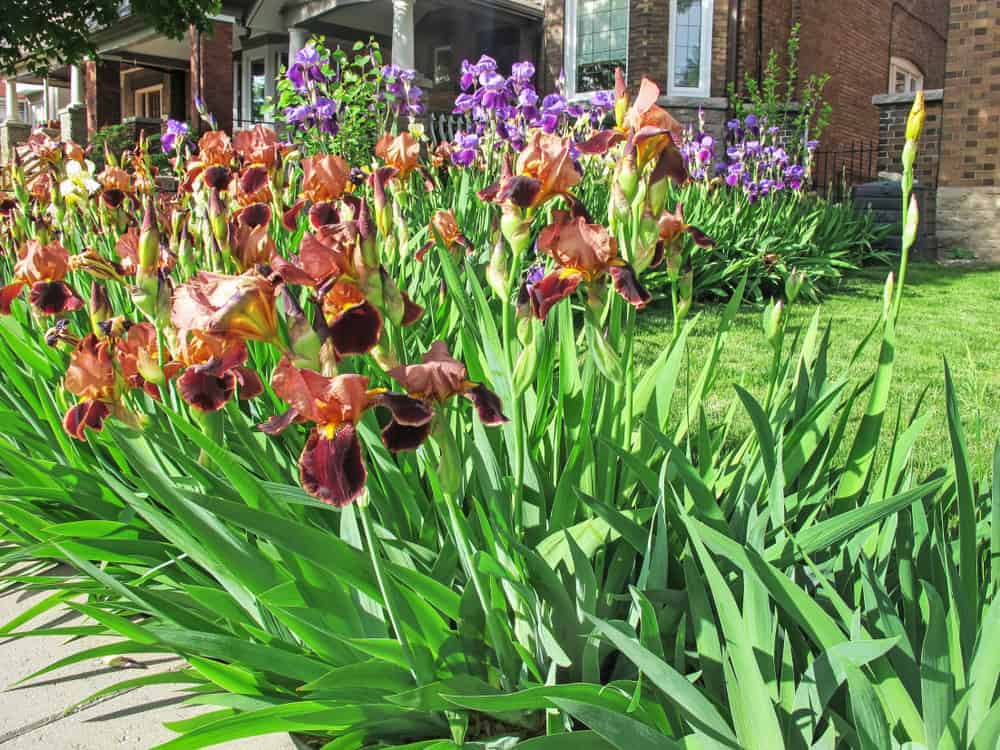
Leave a comment